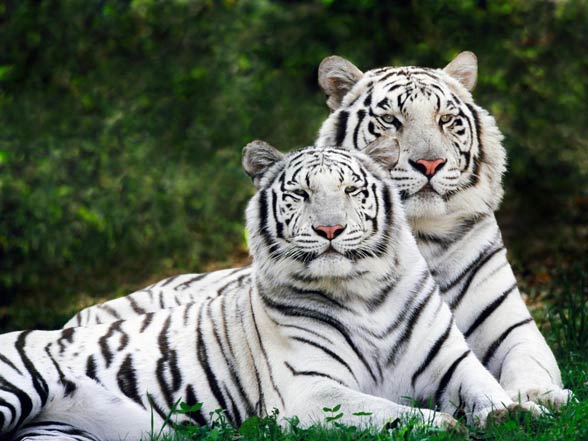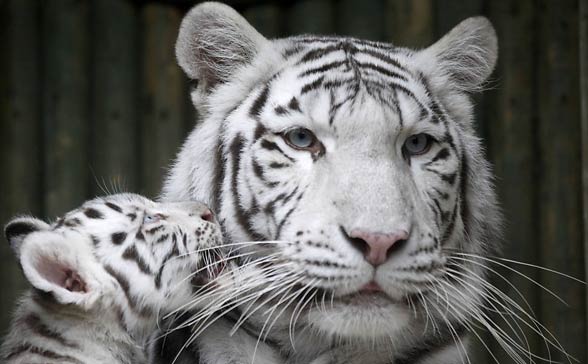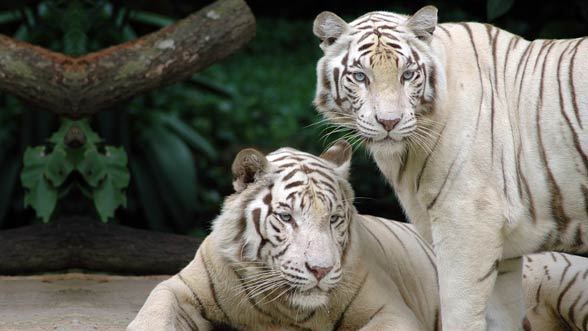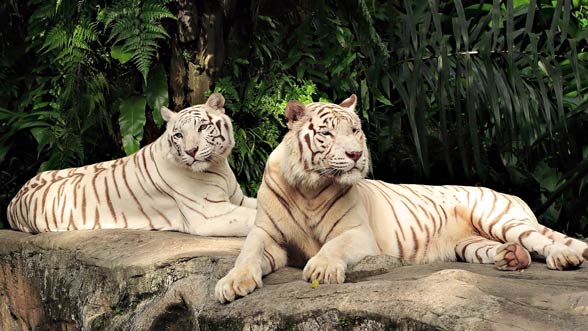White tigers
The white tiger is an extreme rarity in the wild, but when it comes to captivity, it is a symbol of each zoo. What is the reason for the white tiger’s unique coloration? Does this extraordinary color of fur yield more differences in relation to the ordinary tiger? In this article we will try to answer these and other questions.

Characteristics
White tigers don’t produce pheomelanin responsible for the orange color of fur, but they produce a pigment called eumelanin, that is why they’re not albinos. Compared to ordinary tigers, white tigers seem to be slightly bigger, both at birth and in adult life. Kailash Sankhala, a naturalist and the Director of New Delhi Zoo, said in the 60s that one of the functions of the “white gene” might be a heavier body of the white tiger.

Reasons
The reason for the occurrence of white tigers in nature is the lack of red and yellow pigments that are responsible for orange fur. It is believed that it’s caused by a mutation of a gene responsible for the production of tyrosinase (a substance involved in the process of melanin production, which is a group of pigments responsible for skin pigmentation). And a special type of mutation, called gene knockout, causes albinism.
Because the gene responsible for the white color is recessive, in order to make white offspring, both parents need to be white. As a large attraction in zoos, white tigers in captivity are bred by inbreeding, which is the breeding of closely related individuals.
In some white tigers their stripes are also very pale. These tigers are sometimes called snow-white tigers. White tigers, Siamese cats and the California White – a breed of domestic rabbit – have enzymes that react to temperature, which causes the darkening of particular points on fur when it gets cold. A tigress named Mohini was whiter than her relative from Bristol that was more cream-colored. It might have been caused by the fact that Mohini spent less time outside in the winter. White tigers produce a mutated form of the abovementioned tyrosinase, which functions only at some temperatures (below 37°C). For the same reason, Siamese cats and Californian Whites have darker ears, faces, limbs and tails when it gets cold. This phenomenon is called acromelanism.

White Siberian tigers
The existence of white Siberian tigers (Panthera tigris altaica) hasn’t been scientifically proved, despite occasional reports on the occurrence of white individuals in regions where these great cats live. It’s very likely that white Siberian tigers simply don’t exist in the wild, and no individual from this species born in captivity was white, in spite of very intensive breeding over recent decades (crossbreeding of many genetic lineages in order to strengthen and protect genes). Thus, the recessive allele should sometimes occur in such a situation, but it has never occurred in a white individual.
White Bengal tigers
The white, allegedly Siberian tigers found in captivity were not in fact genetically pure representatives of the species Panthera tigris altaica. Such individuals are rather crossbreds between the Siberian and Bengal (Panthera tigris tigris) tigers. In the latter ones, white fur occurs relatively often, mostly in captivity; white Bengal tigers in the wild are a rarity, and only in places where breeding isn’t selective.

Snow-white and golden tigers
The snow-white tiger, which has no black stripes, is a variation of the white tiger. A predator displayed to the public in Exeter (England) in 1820 was one of such individuals. George Cuvier described it as a white tiger with poorly visible stripes, that you could see only when the light fell at a particular angle. Naturalists Richard Lydekker, Hamilton Smith and John George Wood were of the same opinion.
Today’s snow-white tigers are a result of multiple breeding between brother and sister, Bhim and Sumita, the tigers in The Cincinnati Zoo. The gene responsible for the snow-white coloration may come from the tigers’ ancestor – a half-Siberian tiger named Tony. Further inbreeding probably caused the occurrence of a recessive gene responsible for the snow-white color (about ¼ of Bhim and Sumita’s offspring had no stripes). However, it is possible that the offspring with stripes, donated to other zoos, carried this gene. In 2004 in Alicante (Spain), a blue-eyed, stripeless white tiger was born, although its parents were ordinary orange Bengal tigers.
Unique individuals called Golden tigers or Strawberry tigers originate from white tigers, and they’re characterized by golden stripes. They’re likely the orange individuals in whom the gene responsible for the lack of stripes is recessive.

Separate subspecies?
White tigers are not considered a separate subspecies, but a mutation among the classified subspecies. Because of their extraordinary appearance, they are sometimes bred to attract people to zoos.
You can see white individuals, for example, in China, and also in Europe: in West Midland Safari and Leisure Park (Great Britain), in Faunistic Park Le Cornelle (Italy) and in Poland.
Outside Europe, white tigers can be found in Haifa Educational Zoo in Israel.

Genetic defects
White tigers may be cross-eyed (because of improper links between optic nerves and the brain), have club foot, kidney diseases, crooked backbone and twisted neck. Moreover, their fertility is decreased, and they miscarry more often. Some individuals’ faces resemble those of bulldogs, characterized by a snub nose, jutting jaw and wide-set eyes. However, it is suspected that some of these features are associated with improper diet, and not with inbreeding.
A white male named Cheytan (son of Bhim and Sumita) born in The Cincinnati Zoo, died in San Antonio in 1992 from complications after anesthesia due to endodontic therapy. Therefore, it seems that white tigers react to anesthesia in a specific way.

White tigers – interesting facts
- White tigers are bigger than their orange equivalents. Their weight may reach about 300 kg.
- Poor immune system of white tigers is linked with a smaller amount of pigments in the tigers’ bodies.
- An Indian naturalist Kailash Sankhala claimed that white tigers were whiter in the former State of Rewa than in other regions.
- It is believed, that the mortality among white tigers’ newborns is 80%. However, it turns out that the mortality rate among cubs is no greater than among orange tigers bred in captivity.
- German and American stage magicians Siegfried and Roy became famous for having two trained white tigers, and called them royal tigers. The magicians have been engaged in selective breeding of snow-white (stripeless) tigers using white Bengal tigers borrowed from The Cincinnati Zoo and Guadalajara Zoo (Mexico).
- It is estimated, that nowadays there are fewer than 30 strawberry tigers, but many more may carry their extraordinary gene.



















